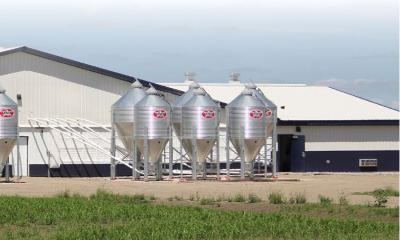

A phytobiotics-based product was found to impact bacterial populations predicted to be involved in lactic acid production and utilization in the gut of weaned pigs.
The diet change and environmental transition of weaned pigs from the farrowing room to the nursery facility often causes weight loss due to minimal feed and water intake and may include post-weaning diarrhea and intestinal dysfunction. Alterations of the swine gut microbiota and gastrointestinal tract have direct effects on digestion, immunity and barrier function, thereby impacting feed efficiency. As additions to feed or water, phytobiotics have shown promise in alleviating some of the negative effects of weaning on piglet health and growth performance.
Phytobiotics are plant-derived products containing any number of biologically active compounds capable of, for example:
- Stimulating feed intake and feed efficiency.
- Providing antimicrobial effects and reducing mortality, and
- Modifying the composition of the gastrointestinal microbiota.
Research at South Dakota State University


Methods Used
At the SDSU offsite wean-to-finish swine barn, two pens of 25 newly weaned pigs each were selected to receive water without or with the commercially available phytobiotic, LiveXtract GrazixTM (Precision Health Technologies, Brookings, South Dakota). Both pens received water from the same county water source, except that the product was injected into the water line of the treatment pen via metered chemical injector (HN55; Hydro Systems Company, Cincinnati, OH, USA) at the rate of 1:128. Phytobiotics-supplemented water was provided for the first 7 days of the nursery period. Individual pigs (16 per group) were selected based on body weight for collection of fresh fecal samples before treatment was initiated, then subsequently at days 4, 10 and 21 of the nursery period. Samples were stored frozen until microbial DNA was extracted for analysis after completion of the trial. Because they can be obtained by non-invasive methods, fecal samples are commonly used as a proxy for assessing differences in gut bacterial composition between experimental groups. The analysis consisted of PCR-amplification of the 16S rRNA gene, followed by Next Generation Sequencing to determine the composition of 16S rRNA gene sequences from each sample (the sequencing service was provided by the SDSU Genomic Sequencing Facility). Since the 16S rRNA gene is present in all bacterial species, it can be used as a reference to determine the different types of bacterial species present in a fecal sample. This technique allows the identification of both characterized and uncharacterized bacterial species, providing a more-comprehensive assessment of gut microbial composition compared to culturing techniques. Bacterial species identified by the DNA sequence of their 16S rRNA gene are referred to as Operational Taxonomic Units (OTUs), and their respective abundance in a sample can be determined from the frequency of their DNA sequence within the pool of DNA sequences that are generated from each sample.
Findings
When comparing bacterial composition between treated and non-treated pigs, thirteen OTUs, each representing a distinct bacterial species, were found to vary in abundance between the groups. Three OTUs found to be higher in the fecal samples from the phytobiotic treatment group were from the genus Lactobacillus, a bacterial group associated with positive effects on health, limiting of pathogen growth, and improvements of gut immunity. More specifically, the three OTUs represented candidate strains of L. reuteri, L. salivarius and L. amylovrus, respectively. In contrast, the abundances of two other OTUs that were lower in the fecal samples of phytobiotics-treated pigs were identified as close relatives of Streptoccus alactolyticus, a species also reported to be a lactate producer. Finally, one OTU related to Megasphaera elsdenii, a known lactate utilizer, was found to be more abundant in samples from phytobiotics-treated pigs. Taken together, these results indicate that phytobiotics can impact populations of lactic acid producers and utilizers in the gut of young pigs.
“Phytobiotics have the potential to improve the microbial balance in the gut of the young pig, leading to improved health and feed efficiency.”
Conclusion
Weaned pigs are subject to nutritional and environmental stressors as they transition from the farrowing room to the nursery facility. These stressors can interrupt the establishment of a stable gut environment, which may lead to disease and/or impaired nutrient uptake. Phytobiotics have the potential to improve the microbial balance in the gut of the young pig, leading to improved health and feed efficiency. Specifically, LiveXtract affected the abundance of lactic acid producing and utilizing bacteria, presumably modulating the levels of an important gut health metabolite that can act as an inhibitor of pathogens and/or as a substrate for the production of propionate, which can be metabolized by intestinal cells. Further research into the biochemical and metabolic functions of plant-based feed and water additives then represents a promising lead towards the development of future products that can benefit gut health in nursery pigs.




